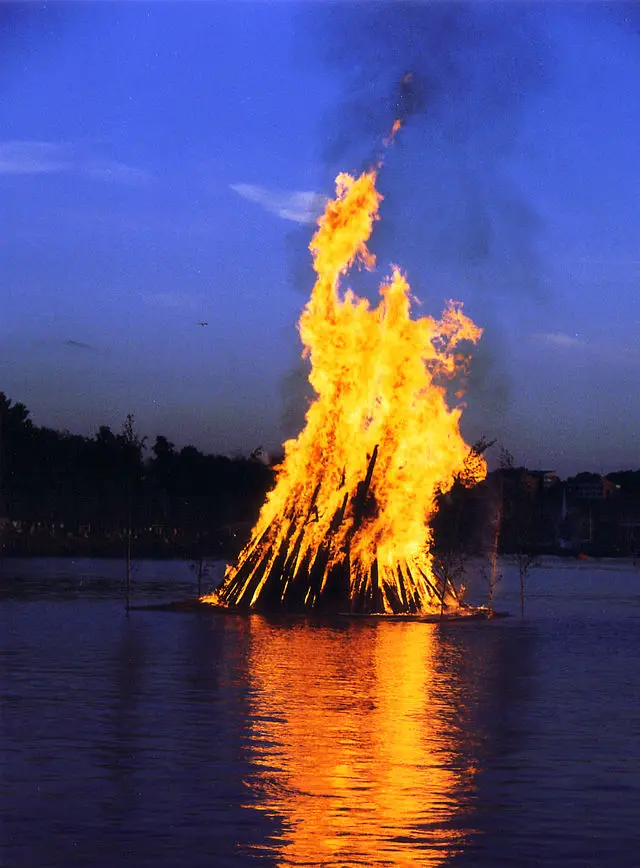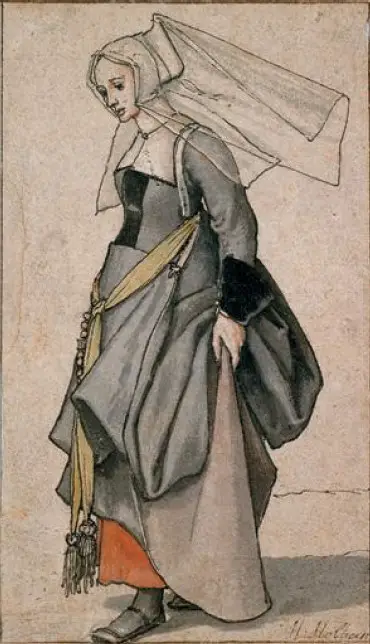 On Saturday 23rd June, Henry VIII and his wife Catherine of Aragon left the Tower of London and made their way through the streets of London to Westminster on their coronation procession.
On Saturday 23rd June, Henry VIII and his wife Catherine of Aragon left the Tower of London and made their way through the streets of London to Westminster on their coronation procession.
Here is chronicler Edward Hall's account of the procession:
"And the morowe folowyng, beyng Saterdaie, the xxiij. day of the said monethe, his grace with the Quene, departed from the Tower, through the citie of London, against whose comyng, the streates where his grace should passe, were hanged with Tapistrie, and clothe of Arras. And the greate parte, of the Southe side of Chepe, with clothe of gold, and some parte of Cornehill also. And the streates railed and barred, on the one side, from ouer against Grace Churche, vnto Bredstreate, in Chepeside, where euery occupacion stode, in their liueries in ordre, beginnyng with base and meane occupacions, and so assendyng to the worshipfull craftes: highest and lastly stode the Maior, with the Aldermen. The Goldsmithes stalles, vnto the ende of the Olde Chaunge, beeyng replenished with Virgins in white with braunches of white Waxe: the priestes and clerkes, in riche Copes, with Crosses and censers ofsiluer, wir censyng his grace and the queue also as they passed. The features of his body, his goodly personage, his amiable visage, princely countenaunce, with the noble qualities 'of his royall estate, to euery man knowen uedeth no rehersall, consideryng, that for lacke of cunnyng, I cannot expresse the giftes of grace and of nature, that God hath endowed, hym with all: yet partly, to discriue his apparell, it is to bee noted, his grace ware in his vpperst apparell, a robe of Crimosyn Veluet, furred with armyns, his jacket or cote of raised gold, the Placard embrowdered with Diamondes Rubies, Emeraudes, greate Pearles, and other riche Stones, a greate Bauderike aboute his necke, of greate Balasses. The Trapper of his Horse, Damaske gold, with a depe purfell of Armyns, his knightes and Esquires for his body in Crimosyn Veluet, and all the gentlemen, with other of his chappell, and all his officers, and houshold seruaiitites, wer appareled in Skarlet. The Barons of the fiue Portes, bare the Canaby, or clothe of estate: For to resite vnto you, the greate estates by name, the ordre of their goyng, the nombre of the lordes Spirituall and temporall, Knightes, Esquires, and Gentlemen, and of their costly and rich apparell, of seuerall deuises, and fashions, who tooke vp his horse best, or who was richest besene, it would aske long tyme, and yet I should omitte many thynges, and faile of the nombre, for they were verie many: wherefore I passe ouer, but this I dare well saie, there was no lacke or scarcitie of clothe of Tissue, clothe of Golde, clothe of Siluer, Broderie, or of Golde smithes workes: but in more plentie and abundaunce, then hath been seen, or redde of at any tyme before, and thereto many and a greate nombre of chaines of Golde, and Bauderikes, bothe massy and greate.
Also before the kynges highnes, rode twoo gentle menne, richely appareled, and aboute their bodies traners, they did beare twoo Robes, the one of the Duchie of Guyon, and the other for the Duchie of Normandie, with Hattes on their heddes, poudered, with Armyns, for the estate of thesame. Nexte folowed twoo persones of good estate, the one bearyng his cloke, the other his hatte, appareled bothe in Golde Smithes woorke, and Broudery, their horses Trapped, in burned Siluer, drawen ouer with Cordes of Grene silke and Gold, the edges and borders of their apparell, beyng fretted with Gold of Damaske. After them came sir Thomas Brandon, Master of the kynges Horse, clothed in Tissue, Eroudered with Roses of fine Gold, and trauerse his body, a greate Bauderike of Gold greate and massy, his Horse trapped in Golde, leadyng by a rayne of Silke, the kynges spare Horse, trapped barde wise, with harneis Broudered with Bullion Golde, curiously wroughte by Golde Smithes. Then nexte folowed the nyne children of honor, vpon greate coursers, appareled on their bodies, in Blewe Veluet, poudered with Floure Delices of Gold, and chaines of Golde Smithes woorke, euery one of their horses, trapped with a trapper of the kynges title, as of Englande, and Fraunce, Gascoyne, Guyan, Normandy, Angeow, Cornewall, Wales, Irelande, &c. wrought vpon Veluettes, with Embrouderie, and Gold Smithes worke.
Then next folowyng in ordre, came the Quenes retinew, as Lordes, Knightes, Esquires and gentle menne in their degrees, well mounted, and richely appareled in Tissues, clothe of Golde, of Siluer, Tynsels, and Veluettes Embroudercd, freshe and goodly to behold. The Quene then by name Katheryne, sittyng in her Litter, borne by twoo White Palfreis, the Litter couered, and richely appareled, and the Palferies Trapped in White clothe of gold, her persone appareled in white Satvn Embrodered, her heire hangyng doune to her backe, of a very great length, bewtefull and goodly to behold, and on her hedde a Coronall, set with many riche orient stones. Next after, sixe honorable personages on White Palfreis, all appareled in Clothe of Golde, and then a Chariot couered, and the Ladies therein, all appareled in Clothe of Golde. And another sort of Ladies, and then another Chariot, then the Ladies next the Chariot, and so in ordre, euery after their decrees in clothe of Gold, Clothe of Silucr, Tynselles, and Veluet, with Embrouderies, euery complement oi thesaied Chariotes, and the draught harnesses, wer poudered with Armins, mixt with clothe of Gold: and with muche ioye and honor came to Westminster where was high preparacion made, aswell for thesaied Coronacion, also for the solempne feast and Justes, thervpon to be had and doen."
You may be interested in reading the poet Stephen Hawes' “A Joyfull Medytacyon to All Englande of the coronacyon of our moost naturall soverayne lorde kynge henry the eyght” which was written in celebration of Henry VIII's coronation. It can be read online at http://archive.org/stream/stephenhawesconv00abbo#page/n33/mode/2up.
Also on this day in history...
- 1576 - Death of Levina Teerlinc, painter and miniaturist, at Stepney. Originally from Bruges, Teerlinc, who was the daughter of Simon Benninck, a master illuminator, travelled to England in the 1540s. Teerlinc was court painter to Edward VI, Mary I and Elizabeth I, and produced many paintings and miniatures.
Notes and Sources
- Halls Chronicle, Edward Hall, p507-509.



Leave a Reply